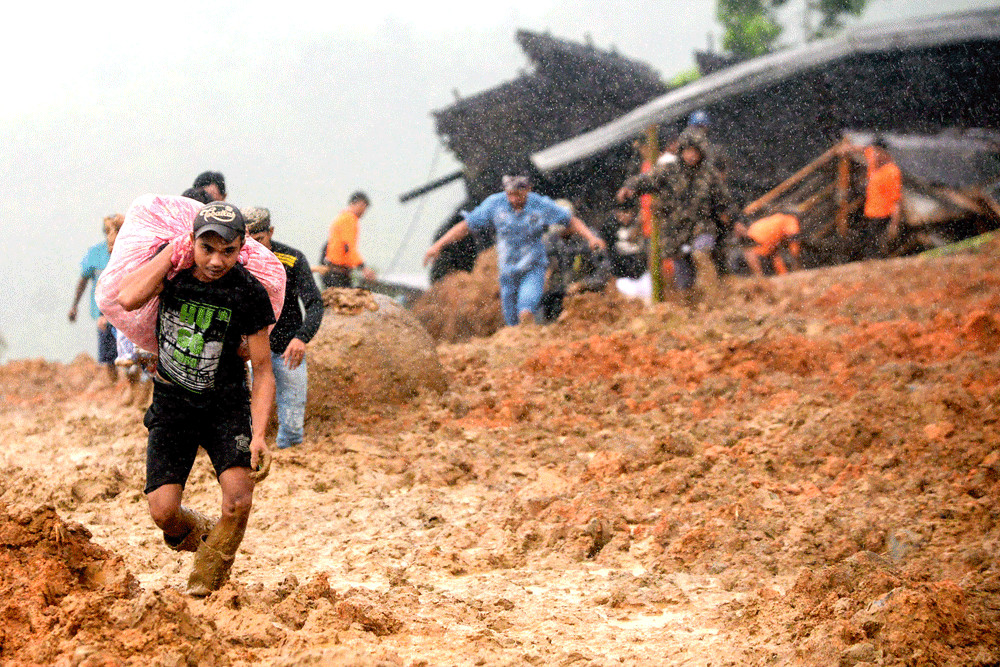Popular Reads
Top Results
Can't find what you're looking for?
View all search resultsPopular Reads
Top Results
Can't find what you're looking for?
View all search resultsSearch for missing goes on after Sukabumi landslide
At least 15 people have been killed and 34 houses buried by the landslide.
Change text size
Gift Premium Articles
to Anyone
R
escuers are still combing through the site of a landslide in Sirnaresmi village of Sukabumi regency, West Java, in an effort to find 24 people who are still missing after 66 were saved, including three with serious
injuries.
Joshua Banjarnahor, the spokesman for the National Search and Rescue Agency (Basarnas) in West Java, said on Tuesday that 32 households, or 101 people, had been affected by the landslide triggered by torrential rain on Monday afternoon.
At least 15 people have been killed and 34 houses buried by the landslide.
“Two people were killed on Dec. 31 and eight on Jan. 1, [including] one baby that was seriously injured and died later on,” he said in a statement, adding that the rescue team had identified 11 bodies so far and that the search would continue on Wednesday.
Banjarnahor said the joint search and rescue (SAR) team of 850 people consisted of personnel from the National Disaster Mitigation Agency (BNPB), the Indonesian Military, the National Police and Basarnas.
“We have deployed two excavators that are already in operation on site,” he said, adding that the team had initially relied only on manual efforts in the search for survivors, which was halted overnight but continued on Tuesday morning.
However, the team was still facing challenges because of the steep and rocky road that destabilized the land. The disaster spot was also hard to reach, located approximately three hours by car from Sukabumi.
Sukabumi military commander Col. Mohamad Hasan explained that his personnel’s efforts to retrieve the victims were hampered by bad weather.
“We have not been able to locate around 20 people who are reported to be missing,” he said.
Kasbani, the head of the Center for Volcanology and Geological Hazard Mitigation (PVMBG), said he had deployed the land movement response team to the site to conduct disaster evaluations, assess the risk of secondary landslides and provide technical advice for the rescue effort.
“The area is still very vulnerable to land and hill movements, given its slope with an angle of more than 30 degrees,” he said.
Kasbani concluded that the cause of the landslide was a combination of high-intensity rainfall, the steepness of the slope and the porous ground that easily absorbed water. The landslide occurred on a hill at an altitude of more than 650 meters above sea level.
“There is a small river next to it,” Kasbani said.
He added that the disaster area had been marked as a zone prone to landslides on a map showing land movement risks in Sukabumi, which meant land movement could occur amid strong rainfall, especially in areas near river valleys and precipices or on cliff roads.
In recent days, seasonal rain and high tides caused landslides and flooding across much of the country.
On Sunday, a landslide struck two bridges on the Siantar-Parapat crossing in Simalungun regency, North Sumatra, and major flooding occurred in dozens of residential areas along the river in Southeast Aceh.
BNPB head Willem Rampangilei said hydrometeorological hazards accounted for 97 percent of disasters in Indonesia this year, with tropical cyclones and floods being the most common, which were caused by a damaged environment, such as shallow rivers.
Central authorities have forecast that hydrometeorological hazards would remain the most likely natural disasters to happen this year, as the rainy season is expected to peak in January, although the El Nino and La Nina weather pattern might not be too pronounced.
With the legislative and presidential elections slated for April, Willem said, the disaster mitigation agency was prepared to minimize the impact of any natural events, particularly during key dates.
According to the agency’s records, 14.1 million hectares of the watershed have been damaged, which would trigger flooding due to rapid surface changes, including in mountainous areas that were turning into residential areas.
The agency’s spokesman, Sutopo Purwo Nugroho, said according to the Meteorology, Climatology and Geophysics Agency, the peak of the rainy season would be from January to February, and this would increase the risk of disasters in landslide-prone points in Central Java, Bandung, Sumedang, Cianjur, Bogor and Sukabumi. (ggq)
This article was originally published in The Jakarta Post's print edition on Jan. 2, 2019, with the title "Search for missing goes on after Sukabumi landslide".











